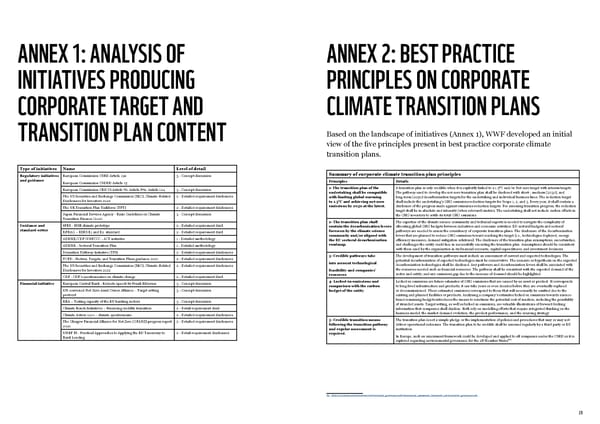29 ANNEX 1: ANALYSIS OF INITIATIVES PRODUCING CORPORATE TARGET AND TRANSITION PLAN CONTENT Type of initiatives Name Level of detail Regulatory initiatives and guidance European Commission CSRD Article 19a European Commission CSDDD Article 15 3 - Concept discussion European Commission CRD VI Article 76; Article 87a; Article 104 3 - Concept discussion The US Securities and Exchange Commission (SEC), Climate-Related Disclosures for Investors 2022 2 - Detailed requirement disclosures The UK Transition Plan Taskforce (TPT) 2 - Detailed requirement disclosures Japan Financial Services Agency - Basic Guidelines on Climate Transition Finance (2021 3 - Concept discussion Guidance and standard-setter IFRS - ISSB climate prototype 2 - Detailed requirement discl. EFRAG – ESRS E1 and E2 standard 2 - Detailed requirement discl. ADEME/CDP/UNFCCC - ACT initiative 1 - Detailed methodology ADEME - Sectoral Transition Plan 1 - Detailed methodology Transition Pathway Initiative (TPI) 2 - Detailed requirement disclosures TCFD - Metrics, Targets, and Transition Plans guidance 2021 2 - Detailed requirement disclosures The US Securities and Exchange Commission (SEC), Climate-Related Disclosures for Investors 2022 2 - Detailed requirement disclosures CDP - CDP’s questionnaires on climate change 2 - Detailed requirement discl. Financial initiative European Central Bank - Keynote speech by Frank Elderson 3 - Concept discussion UN-convened Net-Zero Asset Owner Alliance - Target setting protocol 3 - Concept discussion EBA – Testing capacity of the EU banking sectors 3 - Concept discussion Climate Bonds Initiatives – Financing credible transition 2 - Detail requirement discl. Climate Action 100+ - climate questionnaire 2 - Detailed requirement disclosures The Glasgow Financial Alliance for Net Zero (GFANZ) progress report 2021 2 - Detailed requirement disclosures UNEP FI - Practical Approaches to Applying the EU Taxonomy to Bank Lending 2 - Detail requirement disclosures ANNEX 2: BEST PRACTICE PRINCIPLES ON CORPORATE CLIMATE TRANSITION PLANS Based on the landscape of initiatives (Annex 1), WWF developed an initial view of the five principles present in best practice corporate climate transition plans. 60 https://ec.europa.eu/environment/environmental_governance/pdf/development_assessment_framework_environmental_governance.pdf. Summary of corporate climate transition plan principles Principles Details 1- The transition plan of the undertaking shall be compatible with limiting global warming to 1.5°C and achieving net-zero emissions by 2050 at the latest. A transition plan is only credible when it is explicitly linked to a 1.5°C and/or Net-zero target with interim targets. The pathway used to develop the net-zero transition plan shall be disclosed with short-, medium (2030), and long-term (2050) decarbonisation targets for the undertaking and individual business lines. The reduction target shall include the undertaking’s GHG emissions reduction targets for Scope 1, 2, and 3. Every year, it shall contain a disclosure of the progress made against emissions reduction targets. For assessing transition progress, the reduction target shall be in absolute and intensity (when relevant) metrics. The undertaking shall not include carbon offsets in the GHG inventory to settle its total GHG emissions. 2- The transition plan shall contain the decarbonisation levers foreseen by the climate science community and/or aligned with the EU sectoral decarbonisation roadmap. The expertise of the climate science community and technical experts is needed to navigate the complexity of allocating global GHG budgets between industries and economic activities. EU sectoral budgets and sectoral pathways are needed to assess the consistency of corporate transition plans. The disclosure of the decarbonisation levers that are planned to reduce GHG emissions toward reaching the target (i.e., technologies deployed, energy efficiency measures, demand mitigation solutions). The disclosure of the transition plan assumptions, uncertainties, and challenges the entity could face in successfully executing the transition plan. Assumptions should be consistent with those used by the organization in its financial accounts, capital expenditures, and investment decisions. 3- Credible pathways take into account technological feasibility and companies’ resources The development of transition pathways must include an assessment of current and expected technologies. The potential decarbonisation of expected technologies must be conservative. The scenario or hypothesis on the expected decarbonisation technologies shall be disclosed. Any pathways and decarbonisation levers shall be associated with the resources needed such as financial resources. The pathway shall be consistent with the expected demand of the sector and entity, and any emissions gap due to the increase of demand should be highlighted. 4- Locked-in-emissions and comparison with the carbon budget of the entity Locked-in emissions are future estimates of GHG emissions that are caused by an asset or product. It corresponds to long-lived infrastructure and products; it can take years or even decades before they are eventually replaced or decommissioned. These estimated emissions correspond to those that will necessarily be emitted due to the existing and planned facilities or products. Analysing a company’s estimates locked-in emissions towards science- based remaining budgets introduces the means to scrutinise the potential cost of inaction, including the possibility of stranded assets. Target setting, as well as locked-in emissions, are valuable illustrations of forward-looking information that companies shall disclose. Both rely on modelling efforts that require integrated thinking on the business model, the market demand evolution, the product performance, and the sourcing strategy. 5- Credible transition means following the transition pathway and regular assessment is required. The transition plan is not a simple pledge or the implementation of policies and procedures that may or may not deliver operational outcomes. The transition plan to be credible shall be assessed regularly by a third party or EU institution. In Europe, such an assessment framework could be developed and applied to all companies under the CSRD as it is explored regarding environmental governance for the 28 Member States 60 .
 Corporate Sustainability & Transition Plans Page 14 Page 16
Corporate Sustainability & Transition Plans Page 14 Page 16